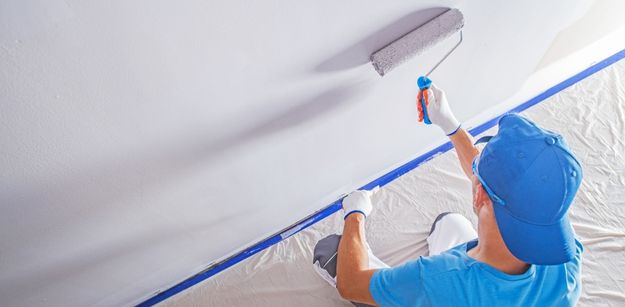There are many factors to consider when painting commercial bathroom stalls that will be utilized in public facilities by many people.
Commercial restrooms are constantly used and need to be as cleanable and durable as possible. Businesses want to keep a strong image and having a clean, visually appealing bathroom environment can make all the difference in today’s culture of growing health awareness. Businesses want customers to feel comfortable after entering there bathroom.
According to a survey, Americans rely on public bathrooms so heavily that 64% have consciously chosen to patronize a business because of its clean, well-kept washrooms. In addition, one in three say they would be open to paying to use a tidy bathroom that’s well-stocked.


You can reassure your customers that you genuinely care about their needs by using hygienic and environmentally safe products, while designing a visibly soothing space. A customer’s perception of a place of business can get positively or negatively influenced by the condition of the bathrooms. No business wants to have their bathrooms affect their outlook by customers.
How To Paint Your Commercial Bathroom
In this guide, we offer advice from our years of expertise in painting and other tips to create the best commercial bathrooms.
Ventilation and Airflow
A powerful ventilation system is necessary for every bathroom. A healthy air exchange reduces the likelihood of stuck air and keeps the paint in the bathroom looking new.
As you can see, this suggestion is beneficial for the commercial bathroom. For instance, proper ventilation keeps the bathroom smelling better and lowers the risk of mold and mildew growth because of a buildup of condensation.
Bright Lighting
When you have a well-lit bathroom stall for commercial use, it shows off the colors of the paint and makes your wall shine more brightly. A high-quality bathroom paint works well with pleasant lighting.
Using The Right Durable Paint
Using a precatalized epoxy or a similar paint that is durable and cleanable will help withstand chipping and peeling paint from heavy traffic ware and tare. Epoxy based paints can be used on the bathroom stalls as well as the walls. The right product can help make the stalls and walls easy to clean and give off a clean perception.
Generally speaking, gloss sheen paint is very resilient and can easily handle all the drying and scrubbing. As any good painting company will tell you, high humidity levels can present unique difficulties. Bathrooms need to be cleaned and disinfected more frequently than other rooms in the house, so convenience in cleaning is essential.
Pick materials that will match your walls
Many people will use your commercial bathrooms, so choosing long-lasting finishes is essential. Ceramic tile is a strong choice for flooring because it comes in many colors, has a resilient finish, and is durable in high-moisture areas.
At the same time, you have another choice. Instead of choosing tiles, you can press the button for commercial-grade epoxy based paint for a smooth, sleek appearance. This paint looks smooth, spotless, and professional. They are also incredibly durable and simple to maintain.
Preventing Mold
Not all commercial bathrooms will have showers, but if your bathroom experiences a lot of condensation, you may also need paint that can resist mold and mildew, apart from having reliable ventilation.
We can advise you on which one might be best for your requirements. Use high-quality paint in this frequently used area. A high-quality, extremely durable semi-gloss would hold up well to frequent use for the bathroom cabinets.
Usually, a Mold Killing Primer consists of an EPA-registered antimicrobial to help avoid the development of mold, mildew, and other bacteria and fungi on the paint film. Use non-porous interior and exterior surfaces when applying Mold Killing Primer.
Balance Visual Effect with Neutrality
The maintenance of your commercial bathroom will be much simpler down the road if you paint the walls a neutral color or use neutral-colored wall tile. It’s because neutral colors are simpler to clean with commercial bathroom disinfectant products.
Neutral hues also conceal stains and dirt better than vivid, bright hues. Pertaining to this, using too many neutral colors makes a space look bland and uninviting. To balance out neutral shades, pick fittings and accessories in lighter tones, have the counters done in a more radiant shade, and so on.
Keep Away “Hospice Colors”
The quickest way to make your visitors feel like they’re in an institution is with too much stark white, gloomy gray, or sterile pale blue—not the energy you want to give off in your commercial space! Color schemes can easily set the “vibe” for the rest of your visitor’s visit because they have a known impact on human mood.
Pick Shades To Showcase Your Brand Image
You can easily use colors to improve the statement or image of your company because they express and create various feelings.
Choose earthy red and orange colors if your message is one of revival and power. Blue, green, yellow, or mauve hues are suitable for calming and relaxing environments. Use dark colors if your company wants to project luxury to an affluent market segment. Pick an artistic, bold statement of vivid colors in abstract design elements or patterns if you want your venue to appear whimsical and innovative.
An accent wall where your sinks are can always bring some pizzazz to your bathroom.
Importance of Primer
A primer is necessary when painting new drywall, cabinets or changing a dark color to a light color by acting as a stain blocker, so bleed through flashing doesn’t occur.
Primers are anti fungal or moisture barriers are often used in bathrooms to prevent drywall failure or fungal growth.
Cover With Enough Paint
Even though bathrooms are typically smaller rooms, ensure your crew brings enough paint to avoid running out. For adequate coverage and durability, we advise 2 coats to get the best coverage and uniform finish look.
Painting Commercial Bathroom Stalls Made of Metal
Unfortunately, graffiti creators often write their quirky ramblings on metal bathroom partitions. Regrettably, some people prefer to scratch through the paint with sharp objects. Repainting is your only choice if this occurs.
Preparation
Like any other painting project, success depends on preparation. Before continuing, use a proper cleaning agent to remove soap, oil, glue, or other foreign stains.
Before sanding, use a wire brush to scrub away any rusty areas. Scuff the entire surface area with fine-grade wet/dry sandpaper. The smooth finish on a metal bathroom partition prevents new paint from adhering well.
Start by getting the edges feathered, and remove any scratches or flaking paint. Your hand should be able to smoothly glide across the panel’s surface without encountering any peaks or valleys. Surface irregularities won’t get covered by paint; they get highlighted.
Before painting, use a tack cloth to remove all dust from the surface once it is smooth.
Masking the Hardware
Mask any hardware not already painted if you don’t intend to take the panels apart to paint them. Galvanized or stainless steel connectors do not adhere to paint well. To make cleanup easier, mask them before painting.
If you plan to apply the paint with a spray gun or can, the walls should also get covered in masking tape. Spraying will give the best finish possible without seeing any brush or roller marks.
Right Material
Due to its adhesion to steel, appliance paint is a good choice for this application. When used correctly, it creates a smooth surface, is resistant to stain, and is washable.
Enamel or epoxy paints will adhere to a properly prepared surface and perform well.
We advise against using latex paint. After drying, latex paint is less durable than enamel and is easier to remove from metal surfaces.
Application
The best application method is a spray one. If done correctly, it won’t leave behind any bubbles, brush marks, or other traces of rolling or brushing.
Consider using a high-quality bristle brush if spraying is not feasible for other reasons. Always adhere to the thinning, application, and cleanup instructions that the manufacturer provides.
Additional factors for Safety
The partitions should be removed and disassembled before priming and painting for the best results. If this isn’t viable, ensure the workspace has enough ventilation and wear the right gear for breathing protection. While sanding, wear a mask. While painting, wear a solvent or VOC mask.
How to Prepare Rusted Metal
The natural oxidation process arises when metal is in contact with oxygen and water. If you plan to paint a rusted surface, make sure to give it careful preparation beforehand to avoid problems with adhesion.
Rust removal is crucial to ensuring a resilient, long-lasting finish. Thankfully, metal is sturdy enough to support crude removal practices. Use the right tools to avoid the process taking much longer than required.
- To remove rust from external metal surfaces, use a pressure washer. If the rusted area is indoors, skip this step.
- Put on safety eyewear and work gloves. You can remove loose rust particles by using a wire brush. Use 80-grit sandpaper to eliminate any residual rust flakes.
- Before painting, apply an iron oxide primer to the rusted area. Apply the primer with a brush with natural bristles. Before painting, give the iron oxide primer two hours to dry.
Get The Best Commercial Painting Today!
Most commercial businesses are busy and may not have the time to take on regular maintenance tasks. Avoid delaying and compromising on brand image. Instead, hire experts that know how to achieve the best results.
Get in touch with us now for more details on paint safety in commercial buildings.



